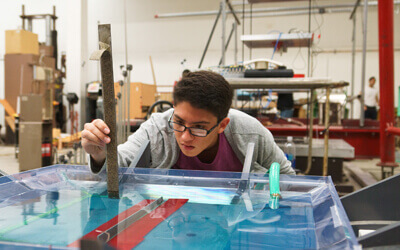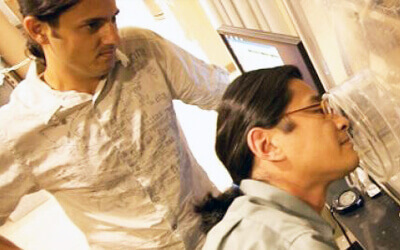
Caffeinated beverages fuel our modern lives. But are you aware of how much caffeine you’re actually consuming? Image/Pixabay.
Coffee is the world’s most popular drink after water. Around 80% of the global population relies on caffeinated drinks just to face the day. But when your morning cup turns into a few refills, followed by that afternoon green tea or energy drink, it’s easy to overdo it and end up facing nasty side effects such as a racing heart or stomach trouble. Yet with caffeine content remaining largely unregulated in beverages, keeping the jitters at bay is still a guessing game.
A research team at USC Viterbi’s Alfred E. Mann Department of Biomedical Engineering is stirring up the coffee scene with a new device to help us track our caffeine intake. Led by WiSE Gabilan Assistant Professor of Biomedical Engineering Maral Mousavi, the team has developed DECAF (Device for Electrochemical Caffeine Analysis in Fluids), a stir-bar sensor designed to offer real-time, precise caffeine measurements right in your cup. The research has been published in the journal Small.
The U.S. FDA recommends a daily caffeine intake of up to 400 mg for healthy adults, which is roughly the equivalent of four 8-ounce cups of coffee.
“If you’re going to Starbucks, that’s just two Grande Americanos,” said the paper’s co-lead author Haozheng Ma, a graduate student in Mousavi’s Medical and Analytical Device Laboratory (MADLAB).

The MADLAB team’s DECAF device. Image/MADLAB.
Depending on the variations in coffee beans and grinds, as well as how the drink is made, it’s not easy to determine exactly how much caffeine is in each cup. Ma and his colleagues were inspired to develop a portable sensor-based solution that can be manufactured for less than $5.
“It’s a gap in knowledge that we wanted to address,” said MADLAB graduate student and paper co-lead author Daniel Vargas Ramos, “This project originated because we’re always consuming a lot of caffeine. But because of that, some of us suffer the negative side effects of too much caffeine, for instance, having trouble sleeping, anxiety, and an upset stomach. So Haozheng came up with a method to measure the caffeine in a solution and that was the origin of us deciding to create this device.”
Current lab-based caffeine-detection methods, such as High-Performance Liquid Chromatography (HPLC) or Gas Chromatography-Mass Spectrometry (GC-MS), are accurate but too expensive, complex, and time-consuming for everyday personal monitoring.

WiSE Gabilan Assistant Professor of Biomedical Engineering Maral Mousavi.
“Right now, there’s only one device, a lateral flow assay, that can only tell you whether or not there’s caffeine in something, not the concentration. However, it will have issues if you have milk in your coffee, which is not helpful if you’re a fan of cappuccinos or lattes,” Mousavi said. “There’s also a very expensive device available that you have to pay several thousand dollars for, but still requires a lot of processing. There is nothing on the market that can do what ours does — a fully integrated system at a reasonable cost.”
So, how did the MADLAB team capture this magic in a simple stir bar? It starts with ingenious engineering. The paddle-shaped DECAF looks like a familiar coffee stirrer, but it’s packed with advanced technology.
At its heart are laser-induced graphene (LIG) electrodes, which have been crafted by precisely engraving common polymer films with a CO2 laser. This process transforms the polymer surface into a highly porous, three-dimensional graphene network – essentially creating a super-sensitive, conductive sponge. This increased electrochemically active surface area is key to DECAF’s ability to detect caffeine with high sensitivity. To ensure accuracy, these LIG electrodes are coated with Nafion, a special polymer that acts like a bouncer, selectively allowing caffeine molecules through while repelling negatively charged interferences found in many beverages, making sure only caffeine gets counted.

Co-author Haozheng Ma.
“You can put it in the beverage when you’re mixing sugar,” Mousavi said. “Once this device makes contact with your beverage, it starts absorbing the fluid. The fluid goes up into the sensing zone, and we have fluidics that process the coffee and have all the reagents needed for the analysis.”
Another innovation is the integrated phosphate-buffered glass fiber (PBS-GF) layer. Beverages can vary wildly in pH, from acidic coffees to more neutral teas. This variability can throw off traditional sensors. The PBS-GF layer is preloaded with a buffer, acting as a mini pH stabilizer, ensuring a consistent environment for accurate readings regardless of the drink’s initial pH. This layer also provides crucial supporting electrolytes, allowing DECAF to work effectively even in drinks with very low conductivity, like purified water, where a distinct caffeine signal would otherwise be absent.
“Our design also corrects for temperature fluctuations during sensing. We tested to make sure that you can use hot or cold beverages; you don’t even have to wait for it to cool down to do measurements without any processing. There’s a lot of detail that has gone into ensuring the accuracy and reliability of the tool,” Mousavi said.

Co-author Daniel Vargas Ramos.
The sensor’s microfluidic channel design actively helps both cold (4 °C) and hot (80 °C) liquids quickly equilibrate to near room temperature as they travel to the sensor, eliminating the need for complex temperature adjustments or correction factors.
The MADLAB team designed the DECAF sensor to require only 200 microliters of your drink —a fraction of a drop —to deliver results in about five minutes, eliminating the need for complex sample preparation. DECAF has also been rigorously tested against common beverage ingredients like glucose, fructose, aspartame, and benzoic acid, ensuring that it accurately detects caffeine without interference from other compounds.
The next stage of the project will enable the DECAF sensor to wirelessly connect to a smartphone, turning your device into a personal caffeine detective with real-time electrochemical readout, data visualization, and storage.
From the busy coffee shop to your home kitchen, the MADLAB team’s DECAF sensor has the potential to transform how we understand and manage our daily caffeine buzz, empowering us to make healthier choices with every sip.
Published on October 1st, 2025
Last updated on October 1st, 2025







